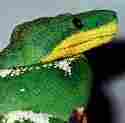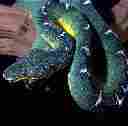
snakes
Wild Animals
alligators
baboons
bears
chimpanzees
crocodiles
deer
dolphins
elephants
foxes
giraffes
gorillas
leopards
lions
seals
sharks
snakes
tigers
whales
wolves
zebras
Pets
dogs
cats
fish
birds
|
This site provides you with the information about snakes, snake information online, snake pictures online, snake photos, snake pics for kids, images of snakes, snake description, free snake info, and more.
If you think that this site is helpful, please recommend your friends to visit our site.
snakes
I INTRODUCTION
Snake (reptile), common name for any reptile belonging to the suborder Serpentes. The body is greatly elongated and most often cylindrical, but the sea snakes and many tree-dwelling snakes have the body compressed laterally. Snakes lack external limbs, although a few still retain tiny remnants of hind legs, the tips of which are visible in large boas and pythons at the base of the tail. The body is covered with scales of a horny epidermal material arranged in regular rows and usually overlapping, like tiles on a roof. The scales located on the back and sides are characteristically smaller than those on the top of the head and along the ventral (under) surface. The scales on the dorsal (upper) surface of the snake may be smooth or bear a long raised ridge or keel; other scale modifications may include small knobs and tiny pits. The skin and outer covering of the horny scales are shed periodically and usually in one piece, including the hard, transparent covering of the eye known as the spectacle; snakes lack movable eyelids, and the spectacle protects the constantly open eyes. The frequency of shedding varies with different species and within a species, according to the size and age of the individual. Young, rapidly growing snakes shed their skins more frequently than the slow-growing adults. In some species the skin is shed approximately every 20 days; in others it is shed only once a year.
II LOCOMOTION
One surprising characteristic of snakes is their ability to move rapidly without legs. Four quite different types of locomotion are used by snakes in getting from place to place. The most frequently used method is the simple, undulating crawl, which is called the serpentine method. In this type of locomotion, the snake pushes against the ground on the back side of each curve or undulation and flows smoothly forward. In another method called caterpillar, or rectilinear, used only by the heavier-bodied snakes, the skin of the ventral surface is moved forward and backward by strong muscles, and the broad belly scales grip the ground, moving the snake forward in a straight line. This method has given rise to the erroneous statement that snakes "walk on their ribs"; actually the ribs do not move forward and backward in any of the four types of movement. Several desert-dwelling species use a special type of locomotion, called sidewinding, to move on loose sand. In this method the snake rolls its body along sidewise along the ground in a looping motion. The fourth method is known as concertina, because the body is alternately stretched out and pulled together as the snake moves from one anchor point to another. The concertina is used in crossing smooth surfaces and in climbing. The most common of the four, and the one that enables all snakes to achieve maximum speed, is the serpentine method. Not all snakes can use each of the other methods. The fastest recorded speed achieved by any snake is about 13 km/h (about 8 mph), slower than a human adult can run, but few can go that fast. In climbing, any of the methods except sidewinding may be used, but snakes swim only by means of the serpentine method. The so-called flying snakes of Southeast Asia and New Guinea do not actually fly, but they can drop or hurl themselves from fairly high trees and fall or even partly glide to the ground without injury.
III STRUCTURE AND FUNCTION
The long, slender body of the snake contains a large number of vertebrae, never fewer than 100 and sometimes more than 300, each with a pair of ribs except the first two. The skeleton is light in structure and is modified to provide great freedom of movement. The skull in particular is loosely built and can be stretched in several directions, permitting the snake to swallow large meals in relation to the size of the head and body. This mobility can be seen especially in the two bones of the lower jaw, which are attached to the skull by a short, movable bone and which are united at the front end merely by an elastic ligament. Both jaws have a large number of sharp, needlelike teeth, all curved toward the rear of the mouth. The teeth are arranged in six rows paralleling the long axis of the head-that is, two rows on each side of the upper jaw and one on each side of the lower jaw. Except in venomous species, the teeth are solid and are replaced periodically. When the snake catches its prey, the recurved teeth enable it to retain a firm hold. The food is killed quickly and swallowed by alternate movement of the rows of teeth, which work to pull the food into the mouth. As the food passes through the mouth, it is covered with saliva; contrary to popular opinion, snakes do not cover their food with saliva before taking it into the mouth. Most meals are swallowed easily and quickly, but a truly large meal may require several hours. The big pythons can consume animals that weigh up to about 68 kg (about 150 lb), but swallowing such a meal is a laborious process.
Venomous snakes have two functional hollow, hypodermiclike teeth, known as the fangs, in the front of the upper jaw. Like the other teeth, they are replaced periodically, and a new fang usually moves into place before the old one is lost. Thus, for a short time, the snake may have two fangs on each side of the jaw. In the solenoglyphs, a large group of snakes including the rattlesnakes and other vipers, the fang-bearing bone (maxilla) is attached to the skull in such a manner that the fangs can be moved back up against the roof of the mouth when not in use. The cobras, coral snakes, and sea snakes represent another large group of snakes, the proteroglyphs, in which the fangs are not very movable but are constantly erect. The fangs are connected by means of the venom duct to the two venom glands, which are modified salivary glands situated on each side of the head behind the eye. The snake must bite to inject its venom; no snake has a stinger in its tail. Snakes can bite at any time and from any position, including underwater. They normally strike out from a defensive coil, projecting the head and front part of the body at the victim. As soon as the head leaves the coil, the mouth is wide open. The solenoglyphs stab the erect fangs into the target and usually withdraw them immediately, either with or without a biting movement. The proteroglyphs usually bite, and the bite may be retained for several seconds. An interesting modification found in only three species of snakes enables them to spit or eject the venom in a fine spray, which is aimed at the eyes of an enemy and projected for distances up to 2.4 m (8 ft). If the venom gets into the eyes, it may cause blindness. The spitting is used only in defense and never to get food.
IV VENOM
The venom is a complex mixture of proteins that destroy various tissues of the body, immobilizing or killing the prey. Venoms frequently are classified in two major categories: neurotoxic, or nerve-affecting, and hemotoxic, or blood-affecting. Actually all venoms contain elements of both types, but one type usually predominates. In general, the neurotoxic type is more effective, usually acting on the central nervous system to produce respiratory failure or suppression of the heart action.
Hemotoxins destroy blood cells, the lining of the blood vessels, and other tissue. Because of the local destruction of circulatory cells, the hemotoxic venom spreads more slowly and has a slower action than the neurotoxins.
V BEHAVIOR
Snakes have a well-developed nervous system and an intelligence intermediate between that of fish and mammals. They show a marked adaptability to captivity, and many become quite tame. The members of many species are nervous and excitable when first caught but usually respond quickly to gentle care. When disturbed in the wild, some snakes go through elaborate bluffing performances; harmless snakes can even appear more dangerous than venomous ones. Although snakes lack a true voice, they often hiss loudly. The bullsnakes and their relatives have a small flap in front of the opening of the windpipe that enables them to produce an extremely loud hiss. Many snakes vibrate their tails back and forth when excited, and if they happen to be in dry grass or leaves, an audible whirring noise is produced. The extreme of this condition is seen in the rattlesnake's horny rattles, which are vibrated at an average rate of 50 times per second. The rattling sound, like the hiss, is a warning to enemies; it is not a lure or a mating sound or a signal to other rattlesnakes. Contrary to popular opinion, the number of rattles does not indicate the age of the snake. A new segment or rattle is added every time the snake sheds its skin, which occurs from one to five times a year, and many segments are broken off from time to time.
Vision is well developed in most snakes, but many burrowing snakes are virtually blind. The sense of smell is acute and is relied on to a large extent in hunting food. Snakes have an auxiliary chemical sense that is widely employed during most activities. The tongue flicks out, picking up odors and carrying them to the roof of the mouth into contact with a sensory receptor called Jacobson's organ. The tongue also receives touch stimuli. Snakes are deaf to airborne sounds. Thus a rattlesnake does not hear the sound of another snake's rattle, nor does the cobra hear the snake-charmer's flute. They can perceive vibrations through the ground or whatever they are resting on, however. The pit vipers, as well as some boas and pythons, have another kind of sense organ, a heat receptor that can perceive small differences in temperature. In the pit vipers the heat receptor is located in the facial pit, between the eye and nostril, that gives the subfamily its name; in the boas and pythons the receptor is located along the labial pits. By means of these receptors the snakes can locate and seize warm-blooded prey at night.
All snakes are carnivorous, eating a variety of animal life from insects, spiders, and snails to frogs, mice, and rats. Oddly, a number of snakes eat only other kinds of snakes.
VI LIFE CYCLE
Snakes reproduce either by laying eggs, which the female usually abandons in some secluded spot, or by bringing forth living young, which are also abandoned. Eggs and young may number as many as 100 at one time, but much smaller clutches are usual. Parental care is entirely absent so far as the young are concerned, but a few species guard the eggs during incubation, and the female python actually broods them. Growth is fairly rapid, and the young reach maturity in from one to five years. The greatest age known to have been attained by any snake is more than 30 years for the boa constrictor, Middle American burrowing python, Indian python, ball python, and timber rattlesnake.
VII DISTRIBUTION
Snakes are found in all the warmer parts of the world, except on a number of oceanic islands. They occur north of the Arctic Circle in Europe, but the number of kinds decreases rapidly from the Tropics poleward. More than 2500 different species are known. They are classified in 10 to 14 families, depending on the system of classification employed. The family Colubridae is the largest family and includes the most common snakes on all continents except Australia, where the Elapidae outnumber all others. This latter group includes some of the most deadly snakes in the world, such as the mambas, cobras, and coral snakes. Two other important groups of venomous snakes are the pit vipers, including the rattlesnakes, the bushmaster, and the fer-de-lance, of the subfamily Crotalinae, and the true vipers, including the adders, of the subfamily Viperinae, both groups are usually placed in the family Viperidae. The largest snakes in the world are members of the family Boidae, which includes the boas, and the family Pythonidae, which includes the pythons. Some members of these families never attain a length of more than 0.6 m (2 ft); the giants occasionally reach a size of 8 to 10 m (26 to 33 ft).
Snakes, through their carnivorous food habits, often play an important part in preserving the balance of life, particularly in the control of such pests as rodents, which tend to multiply at a rapid rate. Snakes are consequently of great service to agriculture in keeping down the numbers of injurious species that afflict the farmer.




|